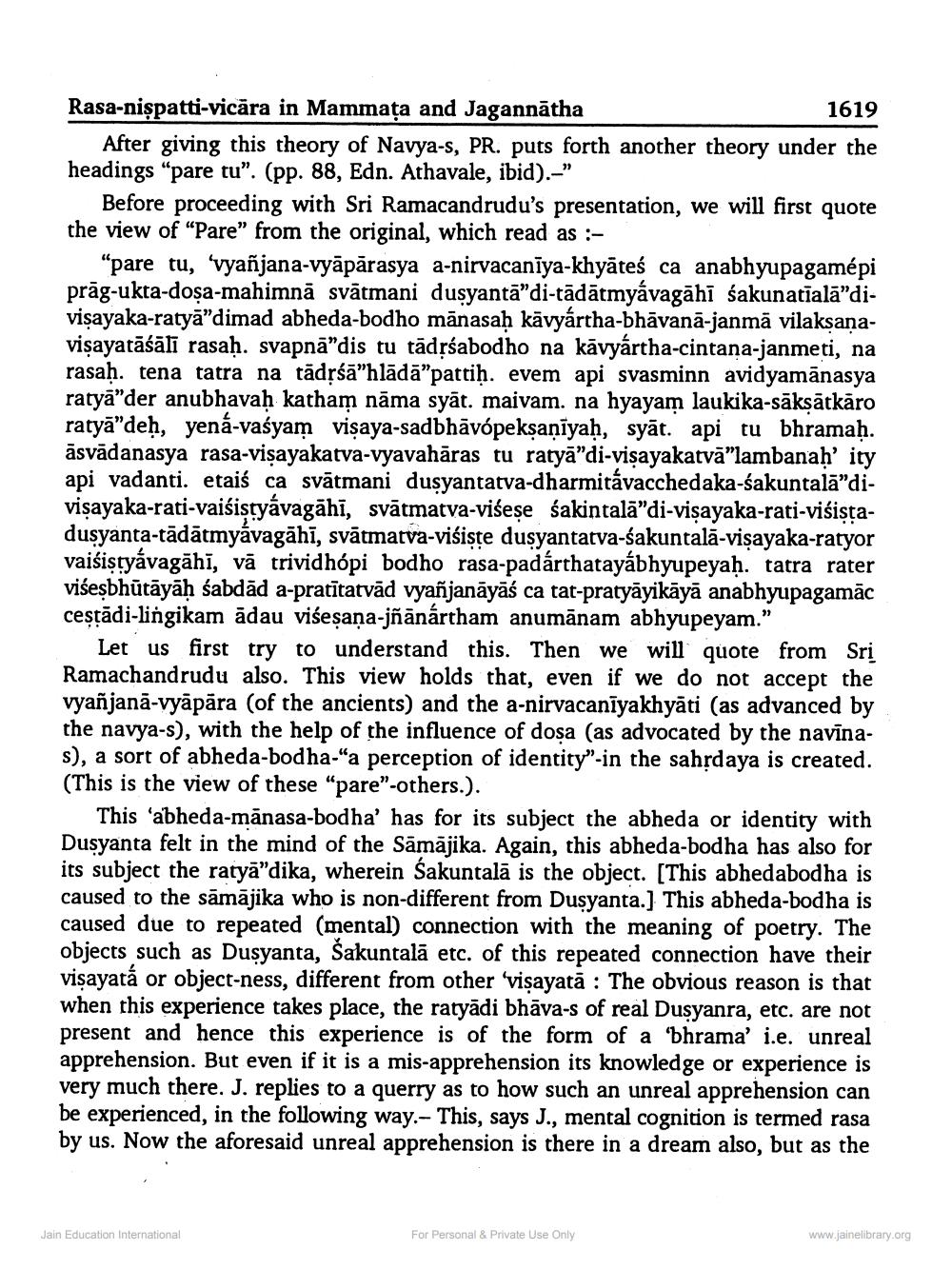________________
Rasa-nispatti-vicāra in Mammata and Jagannātha
1619 After giving this theory of Navya-s, PR. puts forth another theory under the headings "pare tu". (pp. 88, Edn. Athavale, ibid). -"
Before proceeding with Sri Ramacandrudu's presentation, we will first quote the view of “Pare” from the original, which read as :
“pare tu, vyañjana-vyāpārasya a-nirvacanīya-khyāteś ca anabhyupagamépi prāg-ukta-dosa-mahimnā svātmani dusyantā”di-tādātmyảvagāhī śakunatialā"divisayaka-ratyā"dimad abheda-bodho mānasah kävyártha-bhāvanā-janmā vilaksanavisayatāśālī rasaḥ. svapnā"dis tu tādņśabodho na kávyártha-cintana-janmeti, na rasah. tena tatra na tāděśā”hlādā”pattiḥ. evem api svasminn avidyamānasya ratyā"der anubhavah katham nāma syāt. maivam. na hyayam laukika-sāksātkāro ratyā”deḥ, yená-vaśyam visaya-sadbhāvopekṣaṇīyaḥ, syāt api tu bhramaḥ. āsvādanasya rasa-visayakatva-vyavahāras tu ratyā"di-visayakatvā”lambanah' ity api vadanti. etaiś ca svātmani dusyantatva-dharmitávacchedaka-sakuntalā”divişayaka-rati-vaiśistyávagāhī, svātmatva-viśeșe sakintalā”di-visayaka-rati-viśistadusyanta-tādātmyávagāhī, svātmatva-viśiste dusyantatva-śakuntalā-visayaka-ratyor vaišistyávagāhi, vā trividhópi bodho rasa-padárthatayábhyupeyaḥ. tatra rater višeşbhūtāyāḥ śabdād a-pratītatvād vyañjanāyāś ca tat-pratyāyikāyā anabhyupagamāc ceștādi-lingikam ādau viśeșaņa-jñānártham anumānam abhyupeyam."
Let us first try to understand this. Then we will quote from Sri Ramachandrudu also. This view holds that, even if we do not accept the vyañjanā-vyāpāra (of the ancients) and the a-nirvacanīyakhyāti (as advanced by the navya-s), with the help of the influence of dosa (as advocated by the navīnas), a sort of abheda-bodha-"a perception of identity”-in the sahrdaya is created. (This is the view of these “pare"-others.).
This "abheda-mānasa-bodha' has for its subject the abheda or identity with Dusyanta felt in the mind of the Sāmājika. Again, this abheda-bodha has also for its subject the ratyā”dika, wherein Sakuntalā is the object. [This abhedabodha is caused to the sāmājika who is non-different from Dusyanta.] This abheda-bodha is caused due to repeated (mental) connection with the meaning of poetry. The objects such as Dusyanta, Sakuntalā etc. of this repeated connection have their visayatá or object-ness, different from other 'vişayatā : The obvious reason is that when this experience takes place, the ratyādi bhāva-s of real Dusyanra, etc. are not present and hence this experience is of the form of a bhrama' i.e. unreal apprehension. But even if it is a mis-apprehension its knowledge or experience is very much there. J. replies to a querry as to how such an unreal apprehension can be experienced, in the following way.- This, says J., mental cognition is termed rasa by us. Now the aforesaid unreal apprehension is there in a dream also, but as the
Jain Education International
For Personal & Private Use Only
www.jainelibrary.org




